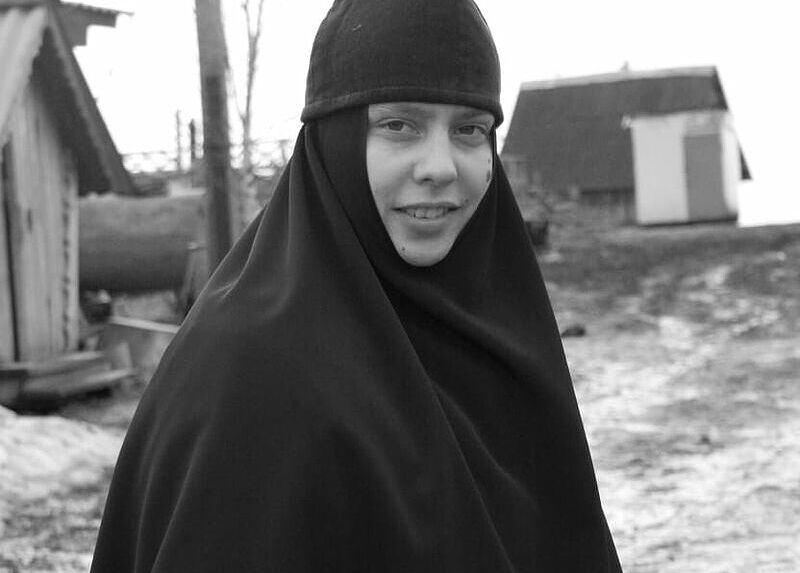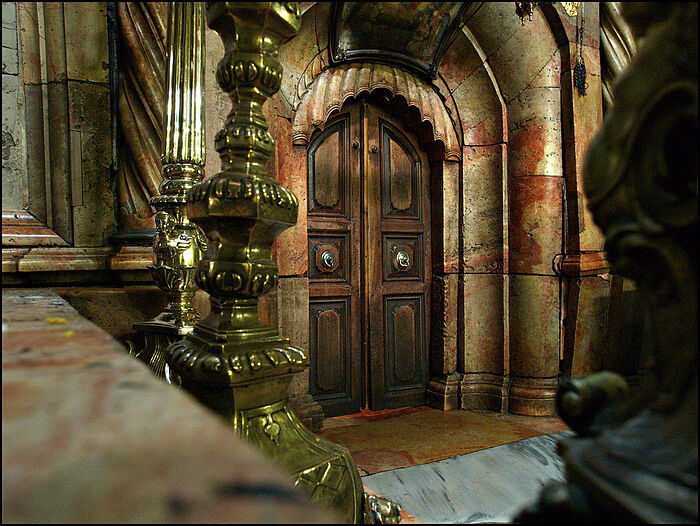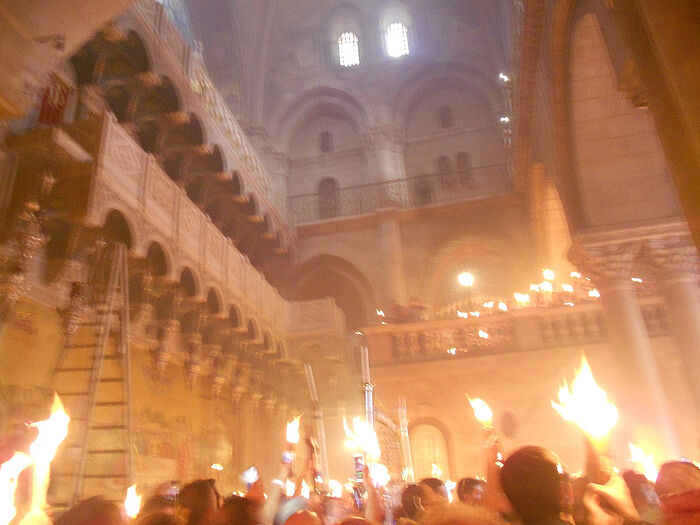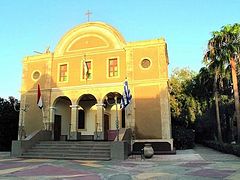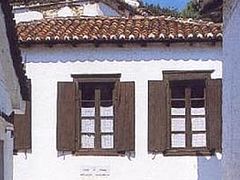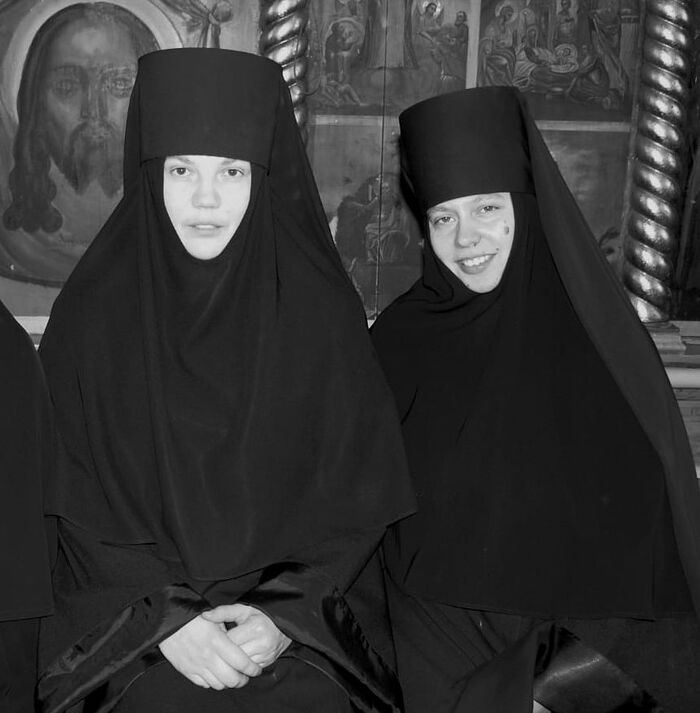 Mothers Elizabeth and Fevronia (right)
Mothers Elizabeth and Fevronia (right)
These stories were shared with me by Mother Sergia, the abbess of Holy Transfiguration Monastery in Usolye, formerly Mother Fevronia of the Kazan-St. Tryphon Hermitage.
First Story: The Holy Fire
In 2013, when I was still Mother Fevronia of the Kazan-St. Tryphon Hermitage, Mother Elizabeth and I, another sister from our monastery, went to Jerusalem for Pascha. We dreamed of seeing the Holy Fire with our own eyes.
To make it in time to get a place in line and get into the Church of the Holy Sepulchre, we had to leave our hotel at night. Our guide tried to talk us out of it:
“Don’t even think about going. Too many people are going to try to get there; a whole crowd of people—it’s too hard. We’ll go later.”
But we resolved to go. We left the hotel at 2:00 in the morning. We were walking through Jerusalem in the middle of the night when suddenly we heard the crowing of roosters. At 2:00 a.m! We immediately remembered the Apostle Peter and all the Gospel events…
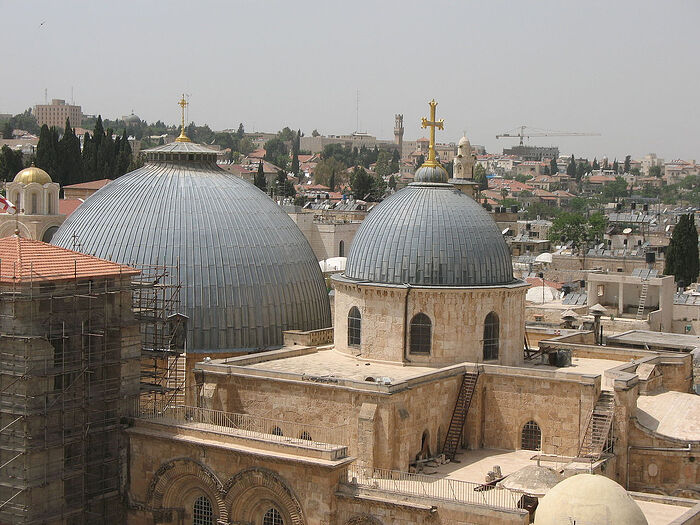 The Church of the Holy Sepulchre
The Church of the Holy Sepulchre
We went to the church and saw a multitude of people there from various countries—who wasn’t there? A lot of people were sitting right there on the sidewalk. We sat down too and started waiting.
By 4:00 in the morning, there were noticeably more people and it was no longer possible to sit, so we stood up in the middle of the crowd that was waiting to enter the church.
The sun came up and the people kept coming. Now we were standing in the midst of a swaying crowd, and it even felt like there wasn’t enough air. Mother Elizabeth is taller than me and it was easier for her. I’m short, and it was very difficult for me.
By 8:00 or 9:00, we were so squished that some people started fainting. Everyone took pity on them and lifted them up over their heads and passed them forward, carrying them out of the crowd. I was holding the candles I had prepared beforehand—they had completely melted.
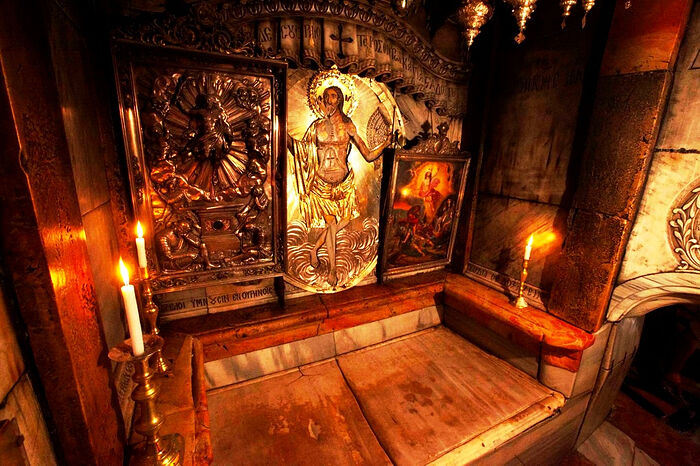 The Holy Sepulchre of the Lord
The Holy Sepulchre of the Lord
From the balconies above, Orthodox Jews were looking down on us, pointing at us, apparently criticizing us.
By 10:00, the people started entering the church in batches. Mother Elizabeth and I were in the second group, and when they let us in, we immediately ran up to the second floor.
The way the church is arranged, on the first floor is the Anointing Stone (according to tradition, it’s part of the stone rolled away from the Holy Sepulchre by the angel), and the Edicule—the small yellow and pink marble chapel with the Lord’s Tomb and the Angel’s Chapel, and on the second floor is Golgotha and the Cross of the Lord. We went up there and started waiting for the Holy Fire to descend, which usually happens around 2:00 PM.
There were more and more people in the church, representing “all the nations,” all peoples. You could hear them talking in various languages from all corners of the Earth. We were waiting, and at 2:00, the Patriarch of Jerusalem arrived and his attendants led him to the Edicule. The people froze in anticipation.
I was watching intently, and suddenly I saw flashes begin to appear in the air—flashes of light, like camera flashes. But it wasn’t cameras at all—it was the Uncreated Light.
We felt the strongest excitement, even fear—the sharp sense that we’re unworthy to see this miracle. Then I understood the Apostle Peter, who while catching so many fish, exclaimed: Depart from me; for I am a sinful man (Lk 5:8).
Suddenly, in a lightning-fast wave, the Fire had engulfed the entire church! All the candles instantly lit up! There are small windows in the Edicule through which the Patriarch passes the Holy Fire. There are Orthodox Arabs standing there who then quickly run with lit candles down the paths cleared for them in advance and pass the Fire to everyone. Thus, it spreads throughout the whole church very quickly.
There began such a buzz—a real exaltation! Everyone was singing, “Christ is Risen from the dead” in their languages: Greeks, Italians, Romanians, Bulgarians, French, Arabs, Russians. Everyone started hugging. You didn’t know who was standing next to you, you didn’t know which nationality he was, but you felt such love for him, like he was your beloved relative—after all, we have one Father, we have one Lord, Jesus Christ…
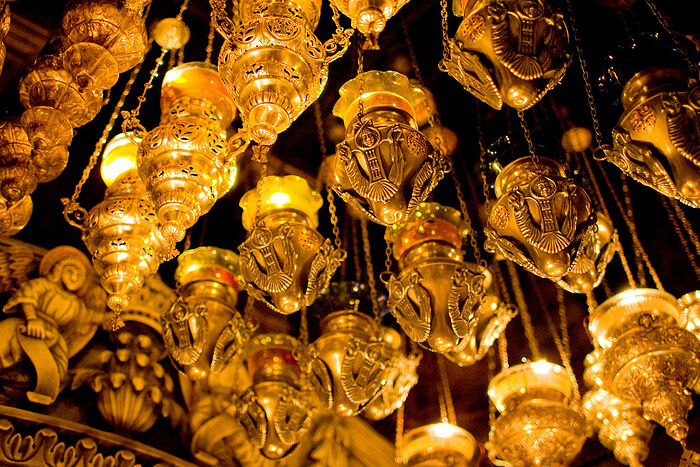 Lampadas on the Lord’s Holy Sepulchre
Lampadas on the Lord’s Holy Sepulchre
People were washing themselves with the Holy Fire, and it didn’t burn their faces. Then the church attendants started asking people to put out their candles, because the Fire gradually takes on the physical properties of an ordinary flame.
It’s a once-in-a-lifetime experience. The Paschal bell began to ring—the universal joy of the Resurrection of Christ!
Mother Elizabeth and I left the church, and then we left Old Jerusalem, and right there by the walls of the Old City, we collapsed on the grass and fell asleep. We were so overwhelmed with emotions that it felt like our physical shells simply couldn’t contain all the grace of the feast.
We slept for two hours, then went to the hotel. The next day, everyone celebrated Pascha, and we communed.
Second Story: Christ is Risen!
Then we went to Mt. Sinai in Bright Week. We climbed the mountain with a small group of pilgrims, where there is the little Church of the Holy Trinity at the top. We prayed during the Liturgy, then started going back down when the guide told us he could take us to an interesting site.
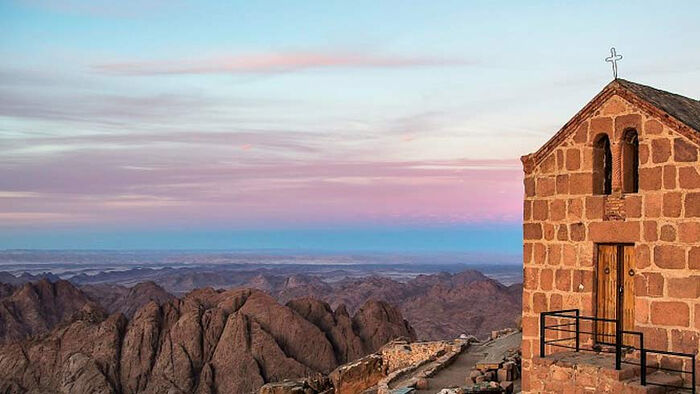 Church of the Holy Trinity on Mt. Sinai
Church of the Holy Trinity on Mt. Sinai
We agreed and followed him along some goat trails through the desert. The sun was up and it started getting really hot. All around was the scent of Sinai sagebrush, greatly heated by the sun’s rays. We walked for about an hour and were very tired, sweating profusely, but I should say that monastics are usually patient.
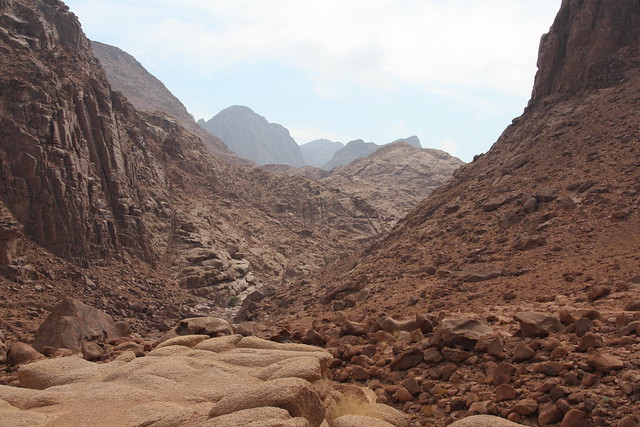 Goat trails to the cave of St. John Climacus
Goat trails to the cave of St. John Climacus
The guide eventually led us to some cave. We saw an elderly nun standing by it. We approached her and asked what this place was. The nun turned out to be French, with the monastic name Maria, but spoke English. She said that it was in this cave that the famous abbot of the Sinai Monastery, St. John Climacus, wrote The Ladder of Divine Ascent.
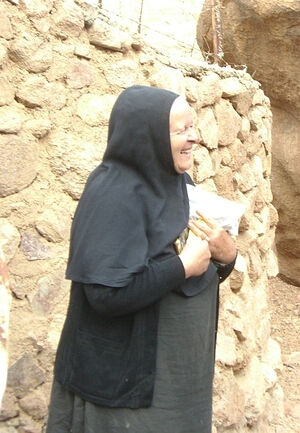 Mother Maria We started asking the nun how she had come to this deserted place. As she told us, she had converted to Orthodoxy long ago and had fervently prayed to St. John Climacus, whom she greatly venerated, that he would show her the place for her monastic life.
Mother Maria We started asking the nun how she had come to this deserted place. As she told us, she had converted to Orthodoxy long ago and had fervently prayed to St. John Climacus, whom she greatly venerated, that he would show her the place for her monastic life.
And for more than fifteen years, with the blessing of her Greek eldress, Mother Maria had been living in this small skete next to the cave. There was one Greek nun laboring with her. The small water source nearby was too weak, but after their fervent prayer before the Lifegiving Spring Icon of the Mother of God, it started giving enough water for their daily life.
Mother Elizabeth and I thought about life in these places: wild beasts, severe temperature changes—unbearable heat during the day and piercing cold at night, Bedouins with their endless internecine wars…
“Mother Maria, it must be scary to live here?”
“It was scary at first, but then I got used to it. God helps us. We have the large and well-maintained Monastery of St. Catherine nearby, and the brothers share food and rusks with us.”
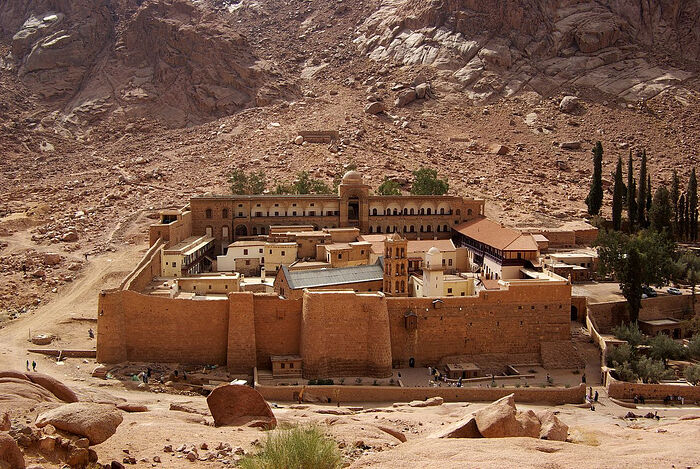 St. Catherine’s Monastery at the foot of Mt. Sinai
St. Catherine’s Monastery at the foot of Mt. Sinai
At some point in the conversation, we realized we were speaking broken English and Russian, and Mother Maria English and French, and yet we understood each other. It was a real miracle. The language of the love of Christ. And Mother herself exuded such love, her eyes shown with such joy that we really just wanted to stay there, with her, in this desert, and be spiritually nourished from her. This is how the love of Christ attracts hearts.
We really wanted to do something nice for her, to please her somehow, so we sang the Paschal troparion in French for her (we’d especially learned the troparion in several languages). Mother started singing along, which united us even more.
We were so joyous about the Resurrection of Christ that we even forgot about the heat, the fatigue and the thirst. In the end, we hugged and said goodbye.
We learned this lesson from this encounter: There’s a special language—the language of the love of Christ, when hearts beat in unison and no interpreter is required.
A few years later, we learned that Mother Maria had departed to the Lord.
Christ is Risen, dear friends! I greet you with the bright Pascha of Christ!

